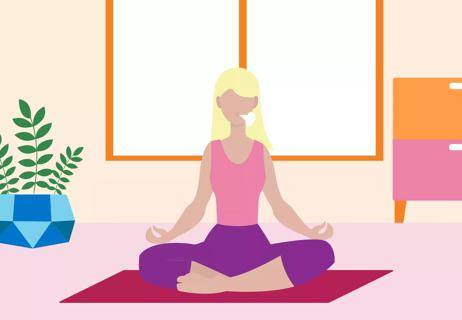Deep sound vibrations made by a soothing instrument may help you decompress

When you’re stressed out, one way you might decompress is putting on your favorite music. For some people that might be streaming aggressive heavy metal. Others prefer to listen to chill classical pieces. Both options are valid — after all, what’s noisy to you might be soothing to someone else.
Advertisement
Cleveland Clinic is a non-profit academic medical center. Advertising on our site helps support our mission. We do not endorse non-Cleveland Clinic products or services. Policy
But if you’re looking for a more formal, dedicated way to gain benefits from sound, you might try a sound bath.
Broadly, a sound bath is an experience where you’re immersed in deep sound vibrations. “The idea is that these vibrations are at specific tones and frequencies and have the ability to heal your body,” says physician assistant Karen Bond, PA-C.
More precisely, sound baths are rooted in the idea that these particular frequencies correspond to specific energy centers in your body. You might be familiar with this concept if you’ve ever done yoga and heard about balancing your chakras. Additionally, traditional Chinese medicine (TCM) is driven by the concept of qi (pronounced “chi”), which translates to the energy or power flowing through your body.
“The idea is that anything that goes wrong with your body corresponds to an imbalance in one of these energy centers,” Bond says. “The sound bath can reset these centers and get your energy moving in the right way. Then the corresponding parts of your body can heal.”
Bond adds that another idea behind sound baths is that not all sound vibrations are created equal. In other words, certain frequencies are said to be beneficial to specific areas of your body. “For example, if you’re coming in with a digestive issue or a stomach problem,” she says, “the therapist should choose a frequency and a tone that is known to correspond to healing in that area.”
Advertisement
Scientists have long studied the health benefits of music. For example, a 2014 systematic review of research studies found that music was a “safe” and “inexpensive” supplemental therapy that helped with pain control.
But there isn’t much research into the science behind sound baths. A 2020 systematic review of four peer-reviewed studies (including one involving people living with metastatic cancer and another with chronic spinal pain) showed possible health benefits after playing or listening to singing bowls. However, the review concluded that more evidence-based research and studies are needed in this area.
Anecdotally, however, Bond says it’s common to feel different after having a sound bath meditation. Things you might experience include:
A sound bath shouldn’t be considered a replacement for any medical treatments you’re having. Instead, it’s better seen as a complementary or supplementary treatment. “Many things out there aren’t in opposition with any treatments we might be receiving from our doctors,” Bond says. “It’s useful to remember that there are complementary therapies available, like a sound bath, meditation, yoga and tai chi.”
A sound bath practitioner doesn’t necessarily need to be a musician. But Bond says they do go through a certification process with formal training to become one, much like a yoga teacher does.
Types of instruments used in sound baths might include:
Bond also says it’s possible to use a digital recording for a sound bath. “However, the best way to do one is in person because your whole body gets to feel the vibration.”
Sound baths affect every person differently. “Some people may feel tired after their sound bath, and some people may feel the opposite — they may feel energized,” Bond notes. “It just depends on the person’s individual concerns and what transformation was made during the session.”
Bond does advise that you should drink plenty of water, eat healthy food and get a good night’s sleep before having a sound bath. “Eat lightly before a sound bath and make sure you’re well hydrated because a sound bath tends to work better,” she explains.
Bond cautions that if you’re living with a psychiatric disorder, you should check with your doctor first to see if having a sound bath is OK.
“It’s essentially the same rules as for meditation,” she states. “If you have a serious psychiatric disorder like schizophrenia and want to start a meditation practice, talk to your doctor first. In some people, meditation can cause or heighten some symptoms of those disorders.”
Advertisement
The length of sound baths varies, and Bond says there’s no optimum duration to get the most benefits. “It’s like meditation,” she notes. “That can also go for any length of time, and it’s beneficial at any duration. With the longer sound bath sessions, you can go a lot deeper into relaxation. But shorter sessions are effective, too.”
Bond suggests wearing loose-fitting clothing to a sound bath, as being comfortable is key. “If you tend to run cold, make sure you bring a blanket because you don’t want to be distracted by feeling too cold,” she continues. “If you tend to run warm, make sure you’re dressed in loose clothing.”
Usually, people will lie down on the floor to have a sound bath, although sitting in a chair is also an option. “The idea is for your body to be in a relaxed state where there isn’t any physical tension, or effort,” Bond says. “If you’re lying on a yoga mat, put something underneath your head or under your knees if you have back problems. Whatever it takes to have a comfortable position for your body.”
At the end of the day, a sound bath can be seen as a way for you to get in touch with your mind and your body. Staying in tune with your inner self is usually never a bad thing.
Advertisement
Advertisement
Learn more about our editorial process.
Advertisement

This bedtime exercise can help you fall asleep faster (and stay asleep)

Research is limited on whether halotherapy delivers on its claims

A guide to yoga poses that can help you get balance

Tools to calm, increase mindfulness

All it takes is one minute, a little patience, and an open mind

Deep breaths, exercise and even your favorite scent can help calm those nerves

Type 2 diabetes isn’t inevitable with these dietary changes

Applying a hot or cold compress can help with pain